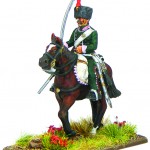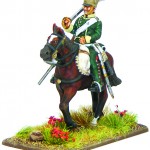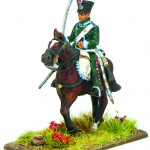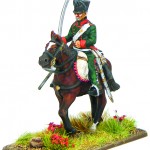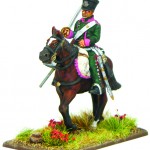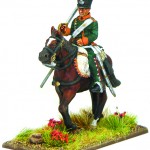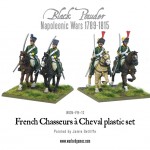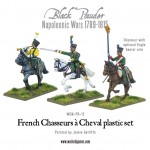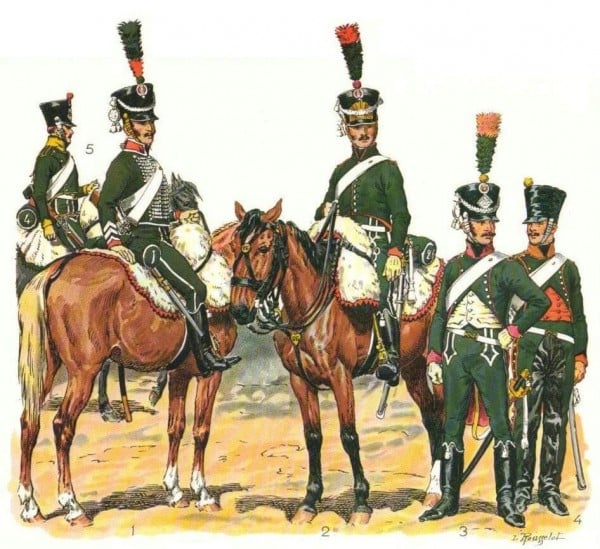
Napoleon’s Eyes and Ears – The Chasseurs à Cheval of the French Army
“A colonel of Chasseurs, or hussars who goes to sleep,
Instead of spending the night in bivouac
in constant communication with his piquet’s,
Deserves to be shot. “
(Napoleon to Berthier 02-01 -1812)
 The role of light cavalry involved reconnaissance and the screening of the main army. This included the posting of piquets in bivouac, providing intelligence and observation of the opposing force, preventing enemy reconnaissance in an effective and efficient manner, plus foraging, escort duties, raiding and pursuit. They were also more than capable of charging knee to knee when required as they proved time and time again on the battlefields of Europe and Russia, together with the hussar regiments, with whom they were often brigaded. The more numerous chasseur regiments, excelled at this function.
The role of light cavalry involved reconnaissance and the screening of the main army. This included the posting of piquets in bivouac, providing intelligence and observation of the opposing force, preventing enemy reconnaissance in an effective and efficient manner, plus foraging, escort duties, raiding and pursuit. They were also more than capable of charging knee to knee when required as they proved time and time again on the battlefields of Europe and Russia, together with the hussar regiments, with whom they were often brigaded. The more numerous chasseur regiments, excelled at this function.
The chasseurs were also capable of dismounted action, like the dragoons. Napoleon’s escort was formed of seasoned veterans selected from all the chasseur regiments.
Several of Napoleon’s generals and even marshalls began their career or were colonels in the chasseurs -Giraud, Grouchy, Murat, Offenstein, Paultre de Lamotte , Quinette de Cernay, Scheglinsky, díUrre, and Watier Saint-Alphonse. One of the most famous was Louis-Pierre Montbrun.
“I considered our (British) cavalry so inferior to the French from the want of order, that although I considered one squadron a match for two French, I didn’t like to see four British opposed to four French: and as the numbers increased and order, of course, became more necessary I was the more unwilling to risk our men without having a superiority in numbers.”
Sir Arthur Wellesley, Duke of Wellington 1818
Organisation
In 1804 there were 24 regiments, and in 1811 as many as 31 regiments. By the time of Waterloo in 1815 (which we shall concentrate on) there were 16 regiments.
More easily trained and more importantly cheaper than hussars, they were the most prevalent of Napoleon’s light cavalry arm.
At Waterloo there were (excluding the guard Chasseurs a Cheval ), the 1st, 3rd, 6th with Ney’s corps in the left wing of the army, the 4th, 9th, 11th and 12th with Napoleon on the right wing (also fighting at Ligny).
During the great battle, the 1st and 6th, having been battered at Quatre Bras, supported the infantry at Hougoumont, the 3rd, with Duruttes Division, conducted the fighting withdrawal with distinction late afternoon in the face of the Prussian advance. The remaining regiments, held in reserve, were sent in late afternoon to face the Prussians at Plancenoit.
Regimental Organisation consisted of 4 squadrons, each of two companies, the 1st squadron having one company of elite troopers, and a regular company. There were also two non-combatant depot squadrons.
1st squadron: 1st (elite) and 5th companies
2nd squadron 2nd and 6th companies
3rd squadron 3rd and 7th companies
4th squadron 4th and 8th companies
Sometimes the elite company was detached from the regiment and served as an escort to a Marshal. If there were several regiments, the Marshal took only 15 men from every elite company. Occasionally whole regiments were seconded for this purpose.
For example in 1812 marshal Berthier and his headquarters were guarded by 28th Chasseur regiment and Saxon light cavalry.
Uniforms and Equipment
Each individual regiment had a distinctive facing colour, the colours of the facings of the Chasseurs never changed throughout the Napoleonic wars.
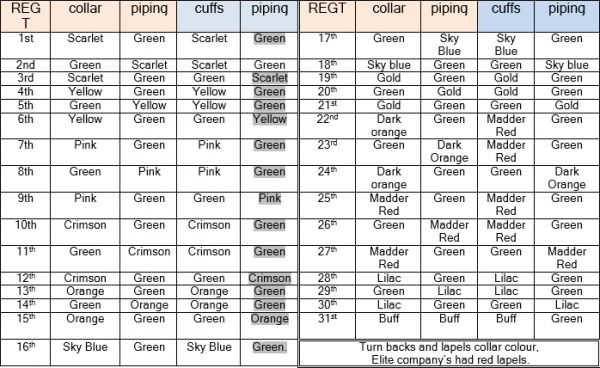
Taken from Oliver and Partridge, Napoleonic handbook
Sample Chasseur facing colours, painted by Tim Harris
It is also relevant to note that some of these regiments were foreign in French service, notably the following;
16th – Belgians.
19th – Swiss, later of Italians.
26th – formed in 1802 of Italians.
27th – formed in 1808 of Belgians and Germans.
28th – formed in 1808 of Italians.
30th – formed in Feb 1811 of Germans,
(in June this unit became 9th Lancers)
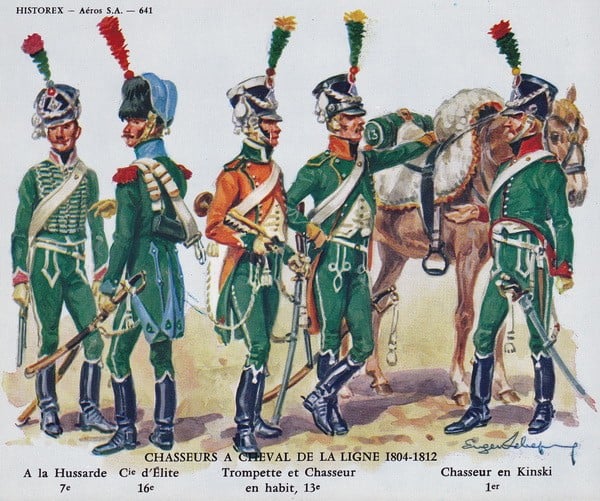
The 1st Company in every regiment was named Elite Company and they rode on black horses. They wore red plumes and epaulettes and had flaming grenade insignia on the coat-tails and saddlecloth.
In February 1812 the elite companies of French Hussar and Chasseur regiments were ordered to adopt shakos with red chevrons and upper/lower bands. Many Chasseurs regiments continued with their colpacks until 1815. The officers in particular were resistant to this change. As such the new Warlord Games Chasseurs have the option of using either headdress.
The Chasseurs wore shakos, green coats, green breeches and short boots. Grey trousers with leather reinforcement were called campaign trousers or charivari.

In 1812 after the campaign in Russia the grey overalls became more popular. Many were made of so-called ‘Marengo-grey’ cloth with black leather reinforcements and 2 stripes along each outside seam. Regulation decreed this be in the facing colour or collar colour of the respective regiment. However this rule was side-lined for mass production to red in most cases. The grey overalls were cheaper and more practical as the Chasseurs participated in numerous marches and counter-marches, scouting often in bad weather.
![]() Before the Waterloo Campaign however the old-style, side-buttoned green overalls had been resurrected. These items came from the regiment’s depot stores. The side-buttoned overalls had proved to be more trouble than they were worth but the light cavalry liked them.
Before the Waterloo Campaign however the old-style, side-buttoned green overalls had been resurrected. These items came from the regiment’s depot stores. The side-buttoned overalls had proved to be more trouble than they were worth but the light cavalry liked them.

To add to the confusion, the cavalry shako pom-pom had more variations. The official version for eight companies within a regiment was:
I Squadron
1st Company – red pompom (Elite Company)
5th Company – red pompom with white centre
II Squadron
2nd Company – green pompom
6th Company – green pompom with white centre
III Squadron
3rd Company – blue pompom
7th Company – blue pompom with white centre
IV Squadron
4th Company – orange or pink pompom
8th Company – orange or pink pompom with white centre.
Full dress uniforms had the plume in green with the tip in the main pompom colour, on campaign it was removed as officers claimed it gave away positions in crops or behind hedges and walls! The exceptions to this were the white plumes for trumpeters and the elite company’s red plume and colpack cover where worn.
We then come to the musicians. In the case of light cavalry these came in the form of a bugler or trumpeter.
The musician uniform consisted of the regulation style trousers, either of green or of grey, with a reverse tunic, in the facing colour with white lace and green collar, cuffs and turn backs. When available, they would ride white or grey horses.
The splendid colours of contemporary battle scenes
are misleading, in reality the colours of most scenes
of carnage must have been a dirty grey-brown.
The Uniforms of the World’s Great Armies 1700 to the Present
It is worth remembering for a realistic touch to your Napoleonic army that dyes at this period were primitive and different batches of uniforms worn by the same unit presented differing shades, especially after exposure to rain and sun.
What the soldiers actually wore in battle depended on several factors:
- Enough time before battle to change or clean the whole outfit.
- Good enough weather (mud, rain, dust etc.).
- Large battle (for a small combat or skirmish it was not worth the hassle!).
- The presence of their monarch.
In 1809 at Sacile, the French 8th Chasseurs a Cheval was full of swaggering men who had bragged about their exploits. They wore their full dress uniform (parade uniform) so as to stand out during the battle. Unfortunately they were routed by Austrian hussars and fled toward the river. It amused the poorly dressed French infantrymen. Other cavalry regiments charged to drive off the pursuing Austrians.
(Remember this for some details about the new Chasseur figures below…)
Eagle and standard
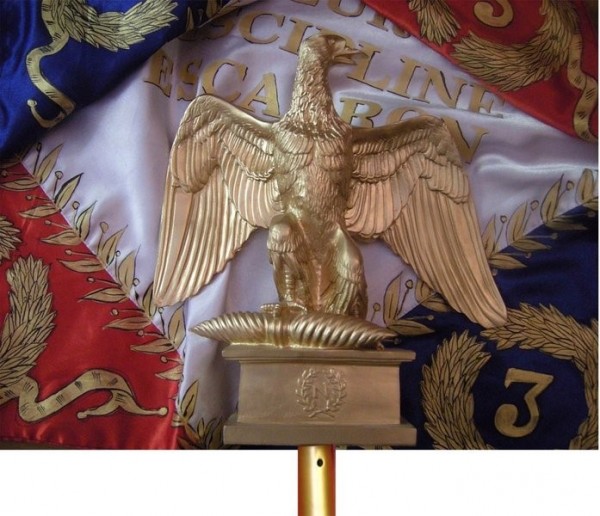 Originally there were 4 Eagles per cavalry regiment of 4 squadrons.
Originally there were 4 Eagles per cavalry regiment of 4 squadrons.
In 1806 Napoleon ordered that regiments of Chasseurs and Hussars deposit all Eagles in safe keeping, either at the depot or behind the lines. Dragoons were to deposit 3 and keep only one in the field and the Cuirassiers retained 3 Eagles per regiment.
Some regiments of Hussars and Chasseurs refused to give up their Eagles and in 1809 (and even in 1812 and 1813) they carried 1 in the field. In 1812 generally no squadron fanions were carried in the field, instead the small company fanions were used.
After much research it appears that the colonel generally decided on whether to carry the eagle and standard into action or to send it with the sappers/non combatants under a junior officer to the rear. As a wargamer I believe the visual effect warrants the eagle and standard being included in the regiment on the board.
Horses and Equipment
“The French cavalry was, on the whole, poorly mounted and poorly equipped; its men were awkward horsemen. Yet it outclassed its opponents simply because, when order rang out and trumpets clarioned ‘Charge!’ it put in its spurs and charged all out, charged home!”
Archduke Charles, commander-in-chief of the Austrian army
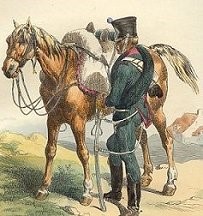
The dolman (plus sash and sabretache) were worn by chasseurs mainly for parade and only seven regiments wore them for field service. The sabretache was a leather case for papers, reports, small items etc. and was suspended by straps from the belt at the left side.

During campaign the ornamented sabretaches were covered by plain black oilcloth. During campaigns in 1813, 1814 and 1815 the sabretaches became a rare sight, and the few still existing were less colourful than those in 1804-1808.
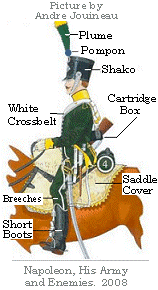
Before campaign the white sheepskin, trimmed in the regiment’s facing colour (or silver for officers, and green edging with black fur to complement the Grey/White horses for musicians), were issued to every chasseur. The sheepskins for light cavalry were bigger than for the heavies. They were used by French, Polish and Austrian cavalry (but not by the Russians and Prussians) for comfort, especially during long marches.
The sheepskins were very comfortable in winter. The problems with them were in summer, they were hot to ride on and in rain they “soaked like sponges”. To make things worse, a lot of humidity and water made the sheepskins badly rot.
The saddle cloth for officers and rank and file was green, edged in the facing colour, and again silver for officers with a silver regimental number in the corner rear. Occasionally these would be a leopard skin for the wealthier officers.
All bridles and metal horse furniture for all ranks would have been silver plated.
Cross belts were white buff leather, occasionally officers would have black, and all buckles and metal work were copper. The exception to this being the 5th and 27th chasseurs that for reasons lost in time wore yellow webbing and belts. Only the musketoon clip was of silver metal.
Horses
During every campaign there was always a shortage of good cavalry horses. In 1805 between Ulm and Austerlitz the French lacked so many horses that the Emperor sent officers to buy horses “of whatever breed” and colour for the cavalrymen.
During peacetime the regiments of light and line cavalry had colour of horses according to squadron :
I Squadron: 1st ‘elite’ company rode on blacks, 5th company on browns and blacks
II Squadron: 2nd company rode on bays, 6th company on bays
III Squadron: 3rd company on chestnuts, 7th company on chestnuts
IV Squadron: 4th and 8th company on greys and whites
However by 1805 only some colonels insisted on keeping up these peacetime practices
John Elting wrote about the horse care in French cavalry:
“Too many French were careless horse masters, turning their animals loose at night into fields of green grain or clover without supervision. Thousands overate and died of the colic. Germans and Poles were more careful.”
Britten-Austin described the situation in 1812:
“Without a drop of water to drink and only an occasional nibble of wayside grasses, they arrive at the first bivouacs utterly spent, collapse, and have to be shot by their riders, who, adding horsemeat to a soup of uncut rye, promptly go down with diarrhoea, an affliction not conducive to brilliant exploits on horseback.”
(Britten-Austin – “1812 The March on Moscow” p 125)
Further Reading:
Elting – “Swords Around a Throne”
Elting – “Napoleonic Uniforms” (superb book)
Hourtoulle – “Soldiers and Uniforms of the Napoleonic Wars”
Haythornthwaite – “Uniforms of Napoleon’s Russian Campaign”
Bukhari-“napoleons cavalry” (courtesy of John Stallard)
Oliver & Partridge- “Napoleonic Handbook II France and her allies.”
Article written by David Matthews
Our new Chasseurs a Cheval Box Set is now available to pre-order, and is due to start shipping out to customers later this month!
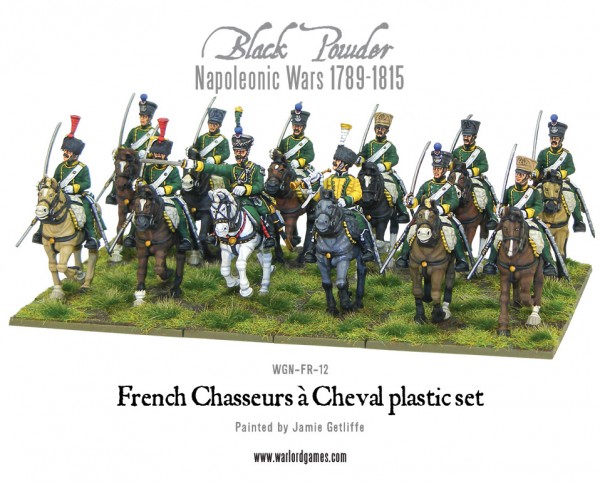
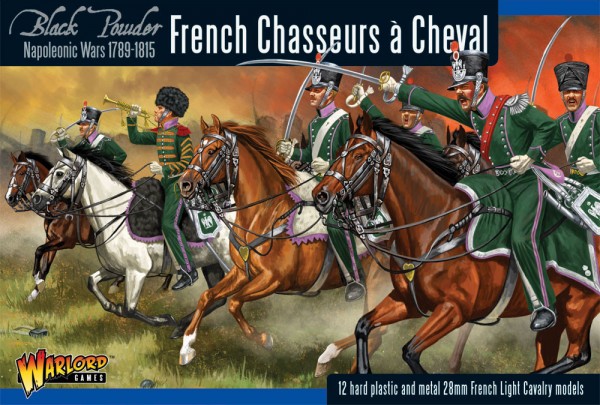
You might also like…
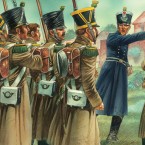 History: French Light Infantry
History: French Light Infantry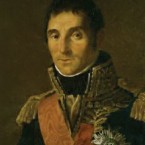 History: Marshal of France Andre Massena, 1st Duc de Rivoli, 1st Prince d’Essling (1758-1817)
History: Marshal of France Andre Massena, 1st Duc de Rivoli, 1st Prince d’Essling (1758-1817)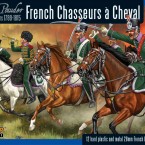 Pre-Order: French Chasseurs a Cheval Light Cavalry
Pre-Order: French Chasseurs a Cheval Light Cavalry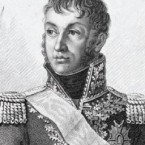 History: Jean Andoche Junot, 1st Duc d’Abrantes (1771 – 1813)
History: Jean Andoche Junot, 1st Duc d’Abrantes (1771 – 1813)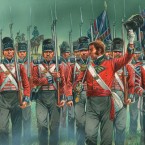 History: The 100 Days Campaign
History: The 100 Days Campaign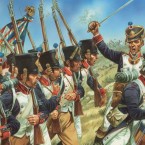 History: Napoleonic French Column vs British Line
History: Napoleonic French Column vs British Line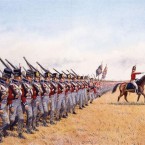 History: The Battle of Talavera 1809
History: The Battle of Talavera 1809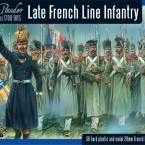 New: Plastic Late French Line Infantry and Casualties
New: Plastic Late French Line Infantry and Casualties

